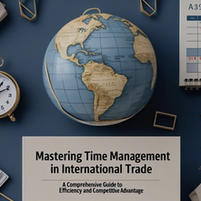A Complete Guide to Incoterms: Understanding DAP (Delivered at Place)
- Mutlu AKGÜN
- Mar 8
- 4 min read
Updated: Apr 10

Introduction
In international trade, clearly defined shipping terms are essential for ensuring smooth transactions between buyers and sellers. Incoterms (International Commercial Terms) establish standardized rules that define responsibilities, costs, and risks during the shipping process.
One of the key Incoterms is DAP (Delivered at Place), which specifies that the seller is responsible for delivering goods to a predetermined destination. This guide will explore what DAP entails, its benefits and drawbacks, and best practices for its effective use in global trade.
What is DAP?
Definition of Incoterms: DAP (Delivered at Place)
DAP (Delivered at Place) is an Incoterm where the seller is responsible for transporting goods to a specific location in the buyer's country. The seller covers all transportation costs and assumes the risk until the goods reach the agreed destination. However, the buyer is responsible for import duties, taxes, and customs clearance.
Key Components of DAP
Delivery Point: The seller must deliver the goods to a designated location, such as a warehouse, factory, or port in the buyer’s country.
Cost Responsibility: The seller covers all costs associated with transportation, including freight and delivery charges.
Risk Management: The seller bears the risk until the goods reach the agreed destination.
Responsibilities of the Seller and Buyer
Seller’s Responsibilities
Transportation: Arrange and pay for all shipping and logistics to the agreed delivery location.
Customs Clearance: Handle export customs clearance in the seller’s country.
Unloading Costs: If agreed upon, the seller may also cover unloading costs at the destination.
Documentation: Provide necessary shipping documents, such as invoices, export licenses, and packing lists.
Buyer’s Responsibilities
Import Customs Clearance: Handle import duties, taxes, and compliance with local regulations.
Risk Assumption: Take over responsibility once the goods arrive at the agreed delivery point.
Final Delivery Costs: If the final destination differs from the seller’s agreed point of delivery, the buyer must arrange further transportation.
When to Use DAP
DAP is ideal in situations where:
The seller has better logistics capabilities and can arrange efficient transportation to the buyer’s location.
The buyer wants a hassle-free delivery experience without managing international shipping logistics.
Customs clearance is manageable for the buyer, and they are prepared to handle import duties and regulations.
The goods are large or require special handling, making it beneficial for the seller to oversee transport.
A flexible delivery location is needed, as DAP can be used for various destinations, including ports, warehouses, or business premises.
Advantages of DAP
✅ Convenience for Buyers: Buyers don’t have to manage international shipping logistics.
✅ Reduced Shipping Risks for Buyers: Since the seller handles transportation, buyers are protected from many shipping risks.
✅ Predictable Costs: Buyers can budget more effectively, as the seller covers delivery costs up to the agreed location.
✅ Flexible Delivery Options: Suitable for various transportation methods and delivery locations.
Disadvantages of DAP
❌ Customs Clearance Complexity: Buyers must manage import duties and local regulations, which may vary by country.
❌ Potential Unforeseen Costs: Import duties and additional charges may increase total costs for the buyer.
❌ Seller-Dependent Shipping Control: Buyers have limited control over carrier selection and shipping schedules.
❌ Risk of Delays: If the seller encounters shipping or customs clearance issues, the buyer may experience delays.
Best Practices for Using DAP
To maximize the benefits of DAP and avoid potential pitfalls, both buyers and sellers should follow these best practices:
Clearly Define Terms: Both parties should agree on the exact delivery point and responsibilities.
Understand Import Regulations: Buyers should research customs duties, taxes, and local import requirements.
Maintain Open Communication: Establish a reliable communication channel to address potential shipping issues.
Ensure Proper Documentation: Accurate invoices, shipping instructions, and customs forms prevent delays.
Consider Insurance: While the seller assumes transport risk, buyers should consider insurance for high-value goods.
Monitor Shipping Progress: Use tracking tools and logistics services to stay informed about delivery status and potential delays.
Negotiate Favorable Terms: Discuss additional provisions, such as who handles unloading costs or potential contingencies.
Conclusion
DAP (Delivered at Place) is a valuable Incoterm that simplifies international shipping by shifting most responsibilities to the seller while allowing buyers control over customs clearance. Businesses that understand when and how to use DAP can minimize risks, improve trade efficiency, and ensure smoother global transactions.
By following best practices, both buyers and sellers can enhance their trade relationships and navigate international shipping with confidence. Whether you are a seasoned importer/exporter or new to global trade, mastering DAP is essential for success in today’s interconnected marketplace.
By leveraging the advantages of DAP and understanding its potential challenges, businesses can optimize their global supply chains and strengthen their international partnerships. This Incoterm is particularly useful in markets where sellers have better access to cost-effective logistics solutions, making it an ideal choice for various trade scenarios.
Incorporating DAP into your shipping strategy can lead to greater efficiency, reduced logistical burdens for buyers, and improved overall trade reliability. Understanding how to navigate DAP effectively will ultimately contribute to smoother, more predictable transactions in global commerce.














